Machine Learning
Bayesian
Overview
- Want to: learn $P(c \vert x)$
- Discriminative models (like LR)
- Generative models: based on $P(x \vert c)$
- For generative model:
- $P(c \vert x) = \frac{P(x,c)}{P(x)} = \frac{P(c)P(x \vert c)}{P(x)}$
- Prior: $P(c)$
- Likelihood: $P(x \vert c)$
- How to describe $P(x \vert c)$
- $P(x \vert c) = P(x \vert \theta _c)$
- For continuous variables: $P(x \vert c) = N(\mu _c, \sigma^2 _c)$ (depends on right assumption)
Naive Bayes
-
Motivation: Calculate $P(x \vert c)$, which is a joint distribution, cannot be estimated from limited samples (curse of dimension).
-
Attribute conditional independence assumption: $P(x \vert c) = \prod _i P(x _i \vert c)$
Bayesian Inference
Example: flip coins
-
Represent data by some parameters: $P(D \vert \theta) = \prod _i P(Y _i \vert \theta) = \theta^{N _+} (1-\theta)^{N _-}$
-
Set prior for $\theta$: $P(\theta)$
-
Calculate posterior for $\theta$: $P(\theta \vert D) = \frac{P(D \vert \theta)P(\theta)}{P(D)}$
EM (Expectation-Maximization) algorithm
- $Z$ is latent variable. Cannot be obsewrved.
- $LL(\Theta \vert X,Z) = ln P(X,Z \vert \Theta)$
- $LL(\Theta \vert X) = ln P(X \vert \Theta) = ln \sum _z P(X,Z \vert \Theta)$
-
For GMM clustering: $\mathbf Z = (k _1, k _2, …, k _i, …)$, the class label for each data point.
-
Expectation: $Q(\boldsymbol\theta \vert \boldsymbol\theta^{(t)}) = \operatorname{E} _{\mathbf{Z} \vert \mathbf{X},\boldsymbol\theta^{(t)} }\left[ \log L (\boldsymbol\theta;\mathbf{X},\mathbf{Z}) \right] $
- Maximization: $\boldsymbol\theta^{(t+1)} = \underset{\boldsymbol\theta}{\operatorname{arg\,max} } \ Q(\boldsymbol\theta \vert \boldsymbol\theta^{(t)})$
Unsupervised - Clustering
Validity Index
- External index (compare with reference model)
- Internal index
- Intra-cluster average/max distance
- Inter-cluster min distance, centroid distance, etc.
K-Means
Hierarchical Clustering
GMM (Gaussian Mixture Model)
Known class labels:
- $\mu _k=\sum _i x _{i,k} / N _k$
- $\sigma^2 _k = \frac{\sum _i (x _{i,k} - \mu _k)^2}{N _k}$
Unknown class labels:
- Objective is to maximize likelihood
- $P(\mathbf X) = P(\mathbf X \vert \mu,\sigma^2, \alpha) = \sum _k \alpha _k P(\mathbf X \vert \mu _k,\sigma^2 _k) $
-
Approach: Soft Labels
- Initialization to assign each sample $i$ to class $k$.
- $\mu _k=\sum _i x _{i,k} / N _k$
- $\sigma^2 _k = \frac{\sum _i (x _{i,k} - \mu _k)^2}{N _k}$
- $\alpha _k = \frac{N _k}{N}$
Until Convergence
- Expectation (E) step:
- Calculate the probability of sample $i$ belongs to each class from 1 to $K$
- $p(k \vert x _i) = \frac{p(k)p(x _i \vert k)}{p(x _i)} = \frac{\alpha _{k}N(x _i \vert \mu _{k}, \sigma^2 _{k})}{\sum _{k}\alpha _{k}N(x _i \vert \mu _{k}, \sigma^2 _{k})}$
- Maximization (M) step:
- Re-estimate paramaters
- $\mu _k = \frac{\sum _ip(k \vert x _i)x _i}{\sum _ip(k \vert x _i)}$
- $\sigma^2 _k = \frac{\sum _ip(k \vert x _i)(x _i-\mu _k)^2}{\sum _ip(k \vert x _i)}$
- $\alpha _k = \frac{\sum _ip(k \vert x _i)}{N}$
- Detailed proof for GMM clsutering: https://en.wikipedia.org/wiki/Expectation%E2%80%93maximization _algorithm
Semi-supervised learning
Self-training
- Train $f$ from $(X _ll, Y _l)$
- Predict on $x ∈ X _u$
- Add $(x, f(x))$ to labeled data
- Repeat
Generative models
- Assumption: labeled and unlabelled comes from the same mixed distribution
-
Compare with GMM-based clustering: labels of unlabelled data can be viewed as latent variable $Z$
-
One way of formulating: $p(X _l, Y _l, X _u \vert \theta) = \sum _{Y _u}p(X _l, Y _l, X _u, Y _u \vert \theta)$
- The combined log-likelihood:
Where:
-
Labelled: $\log p({x _{i},y _{i}=k _i} _{i=1}^{l} \vert \theta ) = \sum _i ln \ p(x _i,k _i \vert \theta) = \sum _i ln\ \alpha _{k _i}p(x _i \vert \mu _{k _i}, \sigma^2 _{k _i}) $
-
Unlabelled: $\log p({x _{i}} _{i=l+1}^{l+u} \vert \theta ) = \ln \sum _i p(x _i \vert \theta) = \sum _i \sum _k \ln \alpha _k p(x _i \vert \mu _k, \sigma^2 _k) $
To be solved by EM algorithm
Semi-supervised Support Vector Machines (S3VM)
- http://pages.cs.wisc.edu/~jerryzhu/pub/sslicml07.pdf
- Main idea: Add loss/penalty term for unlabelled data:
- The third term prefers unlabeled points outside the margin
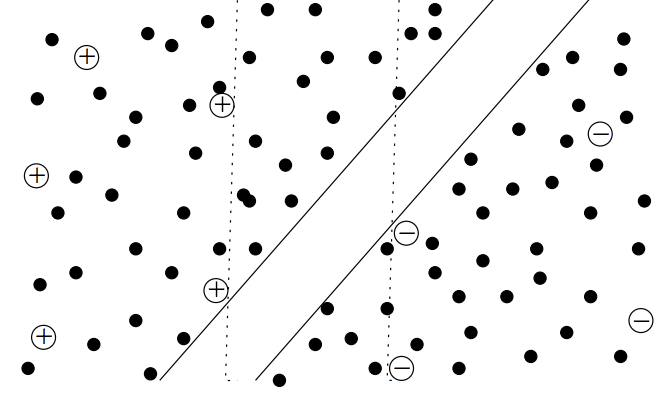

Graph-based methods
PU Learning
- All positive samples + unlabelled samples
Trees
- Use Information Gain to split nodes
- Information entropy: $E _0 = -\sum _k p _k log _2p _k$, where $k$ is class index
- Information Gain $Gain= E _0 - \sum _{node} N _{node}\% \times E _{node}$
- Maximize information gain -> Increase in “purity”
- Example: ID3
- Use Information Gain Ratio to split nodes
- Drawback of information gain: best result will be using “ID” column (i.e., perfect split)
- Fix: Information Gain Ratio $Gain\ Ratio = \frac{Gain}{IV _{feature} }$: to normalized based on number of distinct values
- Example: C4.5: mixed use of information gain and information gain ratio
- Use Gini index to split node
- Gini = $1 - \sum _k p^2 _k$
- Gini index $= \sum _{node} N _{node} \times Gini _{node}$
- Minimize gini index -> Increase in “purity”
- Example: CART
-
Continous variable and Missing values
-
Decision Boundary and Multivariate Decision Tree
- When splitting node, select attribute set instead of single attribute (i.e., left: $w^Tx>0$ , right: $w^Tx<0$)
- Node splitting for Regression Tree
- Find feature $j$ and splitting point $s$ so that:
SVM
How to formulate the problem?
- Most Intuitive formulation
- Maximize Geometric Margin: $\gamma $
- Constraint: $\gamma _i = \frac{y _i (w^Tx _i + b)}{ \vert \vert w \vert \vert } \geq \gamma $
- Define functional margin:
- $\gamma _i = \frac{\hat \gamma _i}{ \vert \vert w \vert \vert }$, where ${\hat \gamma _i}$ is function margin: $y _i f(x _i$)
- Maximize Functional Margin:$Max \frac{\hat \gamma}{ \vert \vert w \vert \vert }$
- Constraint: $\hat \gamma _i = {y _i (w^Tx _i + b)} \geq \hat \gamma $
- Take a step further:
- Scaling $w$ and $b$ by $\hat \gamma$ will not affect decision boundary
- Maximize: $\frac{1}{ \vert \vert w \vert \vert }$
- Constraint: ${y _i (w^Tx _i + b)} \geq 1$
See Notes below for how to re-formulate the problem:
- 1) Original problem: $Min \vert \vert w \vert \vert ^2$
- 2) Unconstraint problem $Min _w\ Max _{\alpha, \beta}\ L(\alpha, \beta, w)$
- 3) Dual problem: $Max _{\alpha, \beta}\ Min _w\ L(\alpha, \beta, w)$ with constraints.
- 4) With SVM satisfying Slater Condition, solve dual problem equivalent to orginal problem
Loss function:
- Min $\lambda \vert \vert w \vert \vert ^2 + \sum _i[1-y _i(w^Tx _i + b)] _+$
Kernel function
- Popular kernels (linear, Polynomial, RBF)
- Polynomial: $k(x _1, x _2) = (x _1, x _2 +c)^d$
- RBF: $k(x _1, x _2) = exp(- \frac{ \vert \vert x _1 - x _2 \vert \vert ^2}{2\sigma^2})$
- How to select kernel
- CV
Logistic Regression
Why usually discretize continuous variables?
- Robust to extreme values (e.g., age = 300)
- Introduce non-linearity (e.g., age < 10, age = 10-15, age > 30)
- Easier for feature interaction
Algorithm
- Prediction function: $p = \frac{1}{1+exp(-f(x))}$, where $f(x) = \theta^Tx$
- Loss function:
- $L = \sum _i ln[p(y _i \vert x _i;\mathbf w)]$; where y = 0,1
- $l(y, p) = -[y ln(p) + (1-y)ln(1-p)]$ ; where y = 0,1
- Exponential Loss:
- $l(y, f) = - y ln[\frac{1}{1+exp(-f(x))}] - (1-y)ln[\frac{1}{1+exp(f(x))}]$; where y = 0,1
- $l(y, f) = ln[1+exp(-yf(x))]$, where y = -1, +1
- Gradient wrt $f(x)$
- $r _{m-1} = \frac{\partial l}{\partial f} = (y-p)$; where y = 0,1
- $r _{m-1} = \frac{\partial l}{\partial f} = \frac{y}{1+exp(yf(x))}$, where y = -1, +1
- Gradient wrt $\theta$
- $\frac{\partial L}{\partial \theta _j} = \frac{\partial L}{\partial f} \frac{\partial f}{\partial \theta _j} = \sum _i(p _i-y _i)x _i^j$ ; where y = 0,1
- $\theta _j := \theta _j - \alpha \frac{\partial L}{\partial \theta _j}$
- How to prove convex optimization:
- $L = \sum _i [-y _i \mathbf w x _i + ln (1+e^{\mathbf w x _i})]$ ; where y = 0,1
Boosting
GBDT (Gradient Boosting Decision Tree)


Summary:
- $r _{i,m}$ is the negative gradient direction for function $f$.
- A regression tree is used to fit the negative gradient direction. (e.g., residual vector in squared error loss)
- Each node split, find best feature and split point
- Another optimization problem is solved to find estimated value for each region (i.e., linear search for step size)
Special cases:
- Square error –> Boosting Decesion Tree to fit residuals
- Absolute error
- Exponential error
- $l(y,f)=exp(-yf(x))$ , where y = -1, +1
- Recovers Adaboost Algorithm
- sensitive to noise data
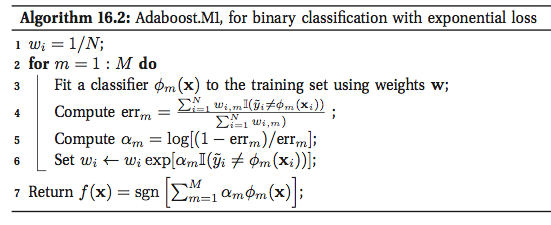
Adaboost
-
Classifer at iteration $m-1$: $f _{m-1}(x) = \alpha _{1}\phi _{1}(x) + \alpha _{2}\phi _{2}(x) + … + \alpha _{m-1}\phi _{m-1}(x) $
-
Classifer at iteration $m$: $f _m(x) = f _{m-1}(x) + \alpha _m \phi _m(x)$
- Minimize exponential Loss: $L(y, f) = exp(-yf(x)) =\sum _i exp(-y _i f _m(x _i)) = \sum _i [exp(-y _i f _{m-1}(x _i)][exp(-\alpha _m y _i \phi _m(x _i))] = \sum _i w _{m,i}\ exp(-\alpha _m y _i \phi _m(x _i))$
- It can be shown that $w _{m,i}= exp(- \alpha _{m-1}y _i \phi _{m-1}(x _i)) \times … \times exp(- \alpha _{1}y _i \phi _{1}(x _i))$
- $w _{m+1, i} = w _{m,i} \times exp(-\alpha _t)$ when correct
- $w _{m+1, i} = w _{m,i} \times exp(\alpha _t)$ when wrong
-
Optimal solution: ($\alpha^* _m, \phi^* _m(x)) = argmin\ L $
- Obviously, $\phi^* _m(x)$ is not affected by the value of $\alpha _m >0$,
- $\phi^* _m(x)$ = $argmin \sum _i w _{m,i} I(y _i \neq \phi _m(x _i))$ (i.e., a classification tree)
- Logistic loss
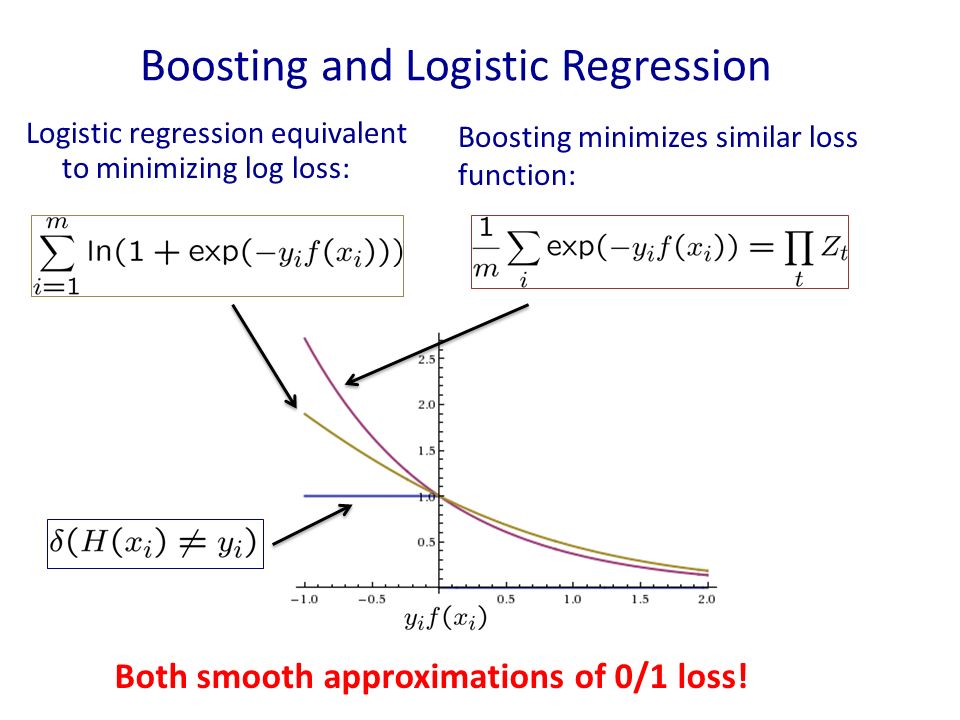
XGBT
-
(Regularization) Added regularization for trees (Number of leaves + L2 norm of leave weights) for better generalization

-
(Second Order) Taylor Expansion Approximation of Loss
- In GBDT, we have first-order derivative (negative gradient)
- Generally we have $f(x + \Delta x) = f(x) + f’(x)\Delta x + \frac{1}{2}f’‘(x) (\Delta x)^2 + …$
- In this case: ($3^{rd}$ order is useless since $\frac{\partial^3 L}{\partial f} = 0$


-
(Bind final objective with tree building) The goal of tree each iteration is to find a decision tree $f _t(X)$ so as to minimize objective (Gain + Complexity Cost):
-
Next Step: find how to split into $J$ regions, and for each region, what is the optimal weight $w _j$.
- $w^* _j$ is derived first, then node split
- In GBDT, squared error is minimized for node splitting
- In XGBoost, directly bind the split criteria to the minimization goal defined in previous step
- Other improvements
- Random subset of features of each node just like random forest to reduce variance
- Parallel feature finding at each node to improve computational speed
- Details: https://xgboost.readthedocs.io/en/latest/tutorials/model.html
LightGBM
- From Microsoft
- https://github.com/Microsoft/LightGBM/blob/master/docs/Features.rst#references
- Problem:
- too many features
- too many data
- (Less Data) Gradient-based One-sided Sampling (GOSS)
- Select top a% large gradient samples
- Select randomly b% low gradient samples, and scaling them up to recover the original data distribution
- (Less Feature) Exclusive Feature Bundling (EFB)
- Bind sparse feature
- From (Data $\times$ Features) to (Data $\times$ Bundles)
- (Better Tree) Leaf-wise grow instead of Level-wise grow
- The resulting tree may be towarding left side)
- But with same number of nodes, the $\Delta Loss$ can be greater compared with level-wise
- Regularize by imposing constraints on tree depth
- (Categorical Split) Splits for categorical data
- Instead of one-hot encoding, partition its categories into 2 subsets.
- (Less Computation) Histogram
- Bucket continuous variables into discrete bins
- No need for sorting like xgboost
- Reduces computation complexity (from no. data to no. bins).
- Reduces memory usage/requirements
- Avoid unneccesary computation by calculating Parent Node and One Child with less data. The other child node can be calculated by Parent - Child
- (Better parallelizing) reduces communication
- Feature Parallel: each worker has full feature set of data (instead of subset); performs selection on subset;
- Data Parellel: merge histogram on local features set of each worker (instead of merging global histograms from all local histograms
Compare bagging with boosting
- Bagging (RF)
- Focus: reduce variance
- Reduce variance by building independent trees and aggregating
- Reduce bias by using deeper trees
- Boosting (GBDT)
- Focus: reduce bias
- Reduce variance by using shallow/simple trees
- Reduce bias by sequentially fitting error
CatBoost
- Treatment for categorical features
- For low-cardinality features: one-hot encoding as usual
- For high cardinality features: use Target-Based with prior
- Advantage - Address Target Leakage: the new feature is computed using target of the previous one. This leads to a conditional shift — the distribution differes for training and test examples.
- Ref: https://catboost.ai/docs/features/categorical-features.html https://towardsdatascience.com/introduction-to-gradient-boosting-on-decision-trees-with-catboost-d511a9ccbd14
- Ref: https://towardsdatascience.com/introduction-to-gradient-boosting-on-decision-trees-with-catboost-d511a9ccbd14
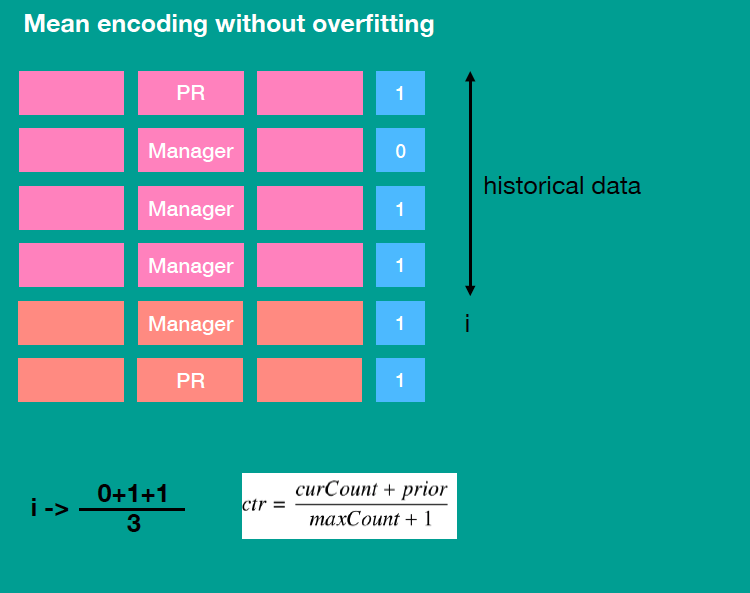
- Treatment for combinations of categorical features
- Calculate Target Statistics for combinaitons of
- categorical features already in the current tree
- other categorical features in the dataset
- Calculate Target Statistics for combinaitons of
- Ordered Boosting
- A special way to address Prediction Shift with a modification of standard gradient boosting algorithm, that avoid Target Leakage
-
detailed to add.
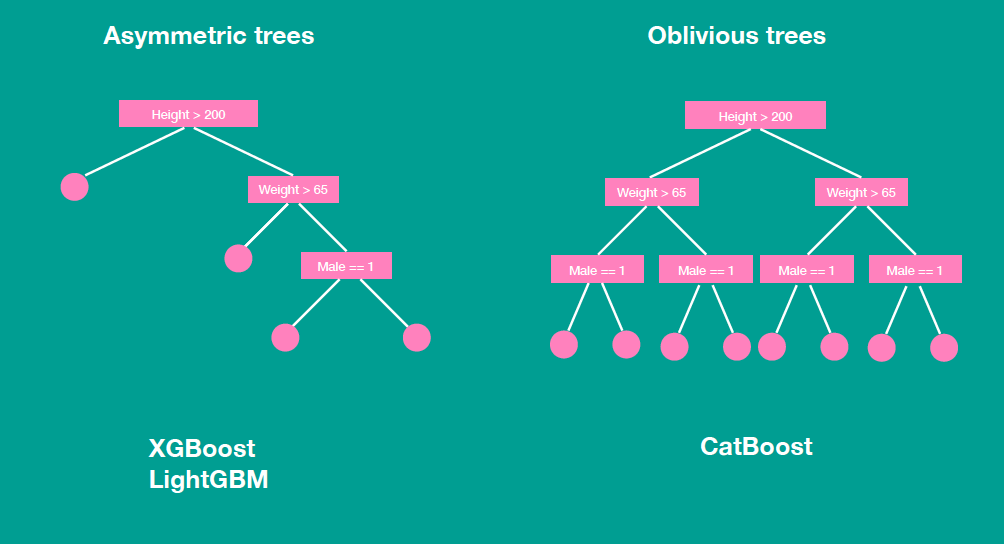
EVD and SVD
EVD
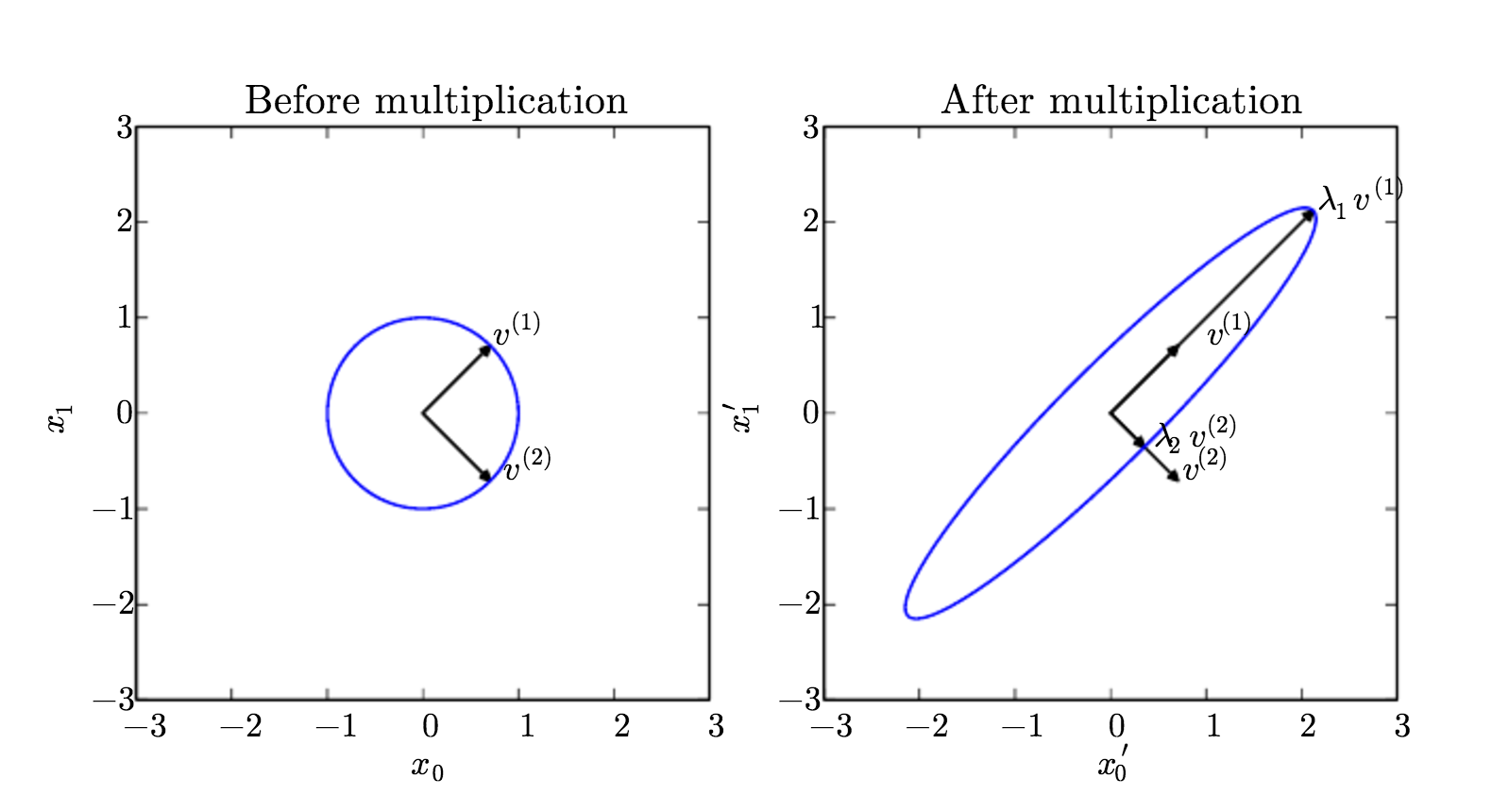
SVD
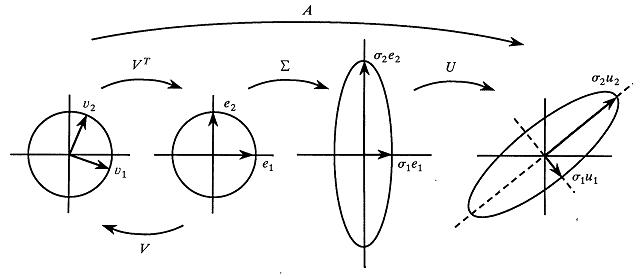
- http://explained.ai/gradient-boosting/index.html
- https://homes.cs.washington.edu/~tqchen/pdf/BoostedTree.pdf
L1 and L2 Regularization
Approach 1:From Figure
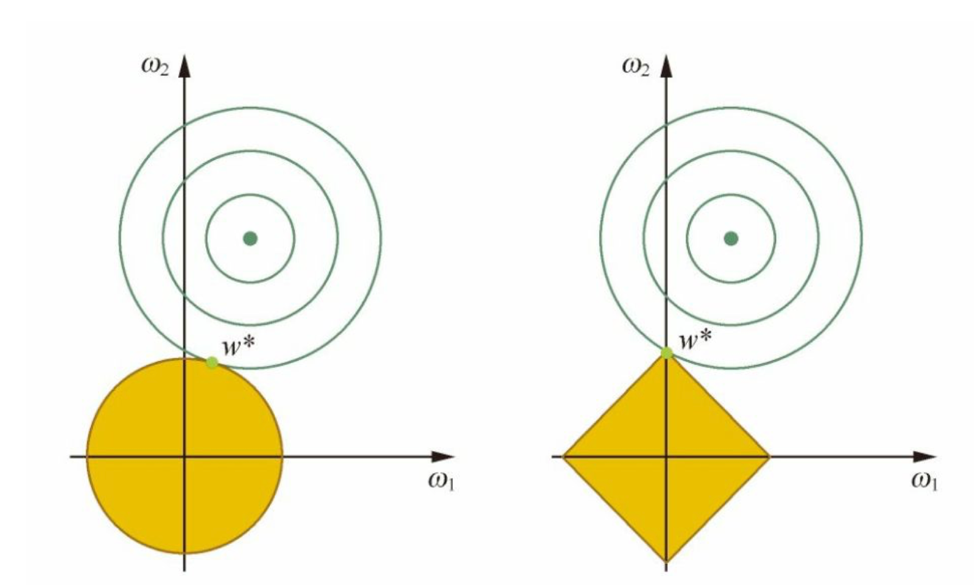
Approach 2: Solve for minumum
Difference in loss function:
- L1: $L _1(w) = L(w) + C \vert w \vert $
- L2: $L _2(w) = L(w) + Cw^2$
Take L1 as example:
- Calculate: $\frac{\partial L _1(w)}{\partial w}$
- When w<0: $f _l = \frac{\partial L _1(w)}{\partial w} = L’(w) - C$
- When w>0: $f _r = \frac{\partial L _1(w)}{\partial w} = L’(w) + C$
- If $ \vert L’(w) \vert <C$ is met (i.e., C is large enough), then we have $f _l<0$ and $f _r>0$, thus minimum is find at $w=0$
Take L2 as example:
- $\frac{\partial L _2(w)}{\partial w} = L’(w) + 2Cw$
- Unless $L’(w=0) =0$, minimum is not at $w=0$.
Approach 3: Bayesian Posterior
Recall the posterior for parameter:
Remove constants:
Solve for $\theta$:
For L1: $\theta$~Laplace Disribution
For L2: $\theta$~Guassian Disribution
Laplace: compared with Guassian, more likely to take zero:
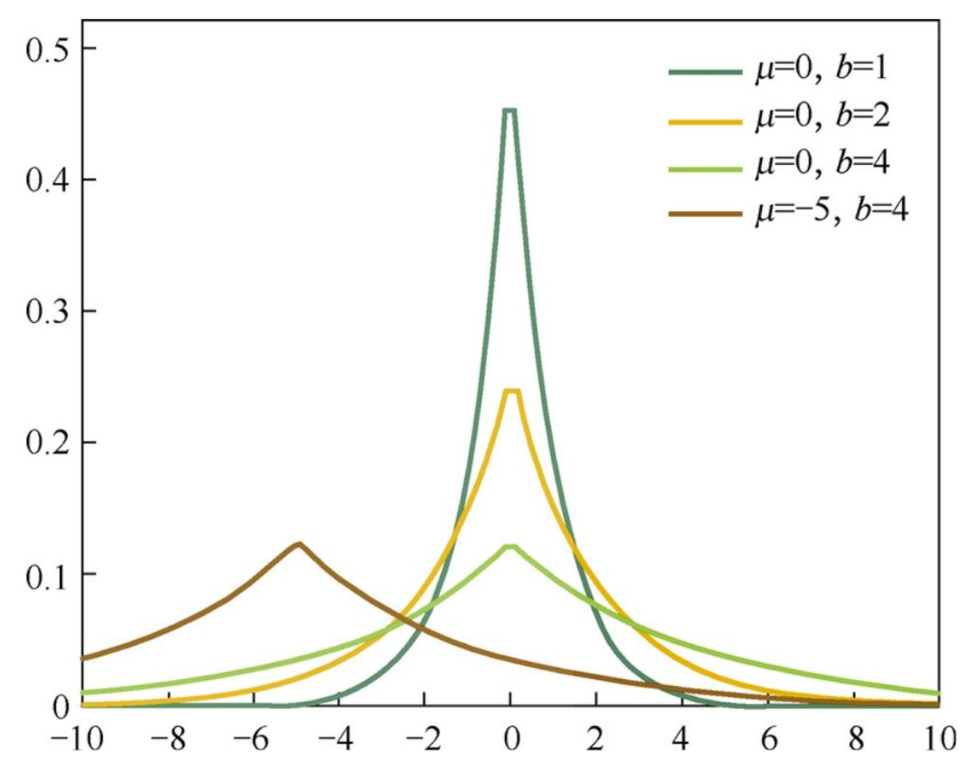
AUC and ROC curve
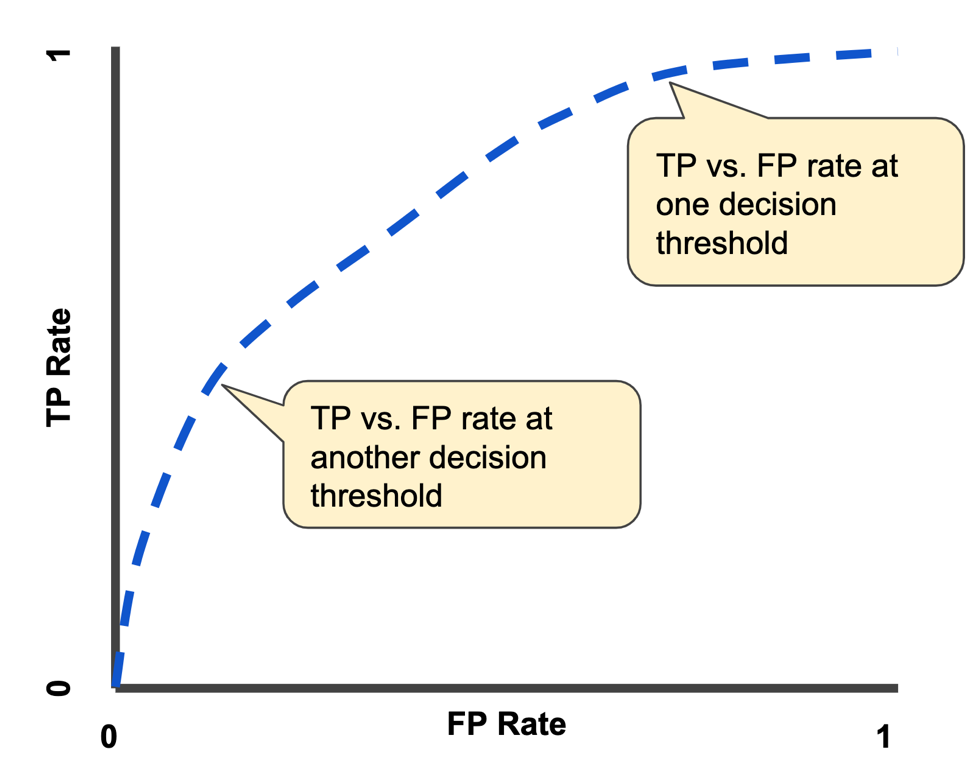
- AUC: For a random (+) and a random (-) sample, the probability that S(+) > S(-)
- Explains why AUC equals to the area under the curve of TPR and FPR:
Miscellaneous
Label Imbalance
- One approach is to use label-aware loss function
- ref: https://arxiv.org/pdf/1901.05555.pdf
-

- With hyperparameter $\beta$ ranging from 0 to 1
- when $\beta$ is 0: no weighing
- when $\beta$ is 1: weighing by inverse class frequency
Different Distribution between Train and Test
- How to tell whether the distribution of train and test set are different
- Train on the label
trainversustest. - A high AUC suggests different distribution.
Selection of loss function for regression
- ref: here
- for high and low values: use MSE
- for medium values: use MAE
- exclude the X% subset with lowest performance in the training
Model Aggregation
- ideal subset of models:
- each model: high performance
- between models: low correlation



